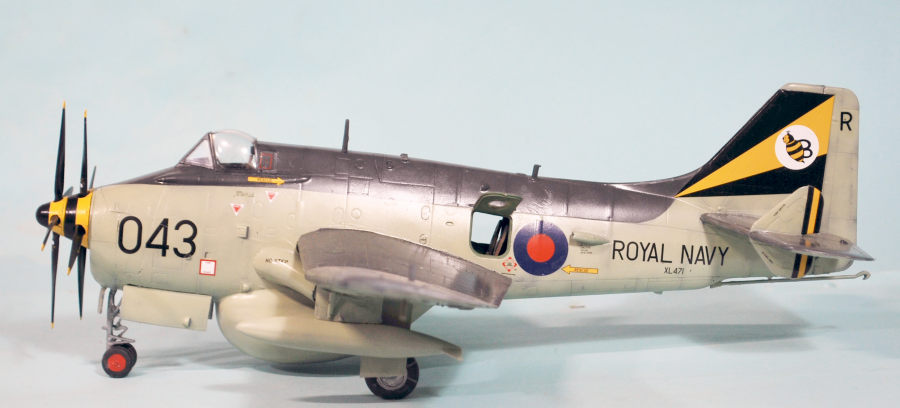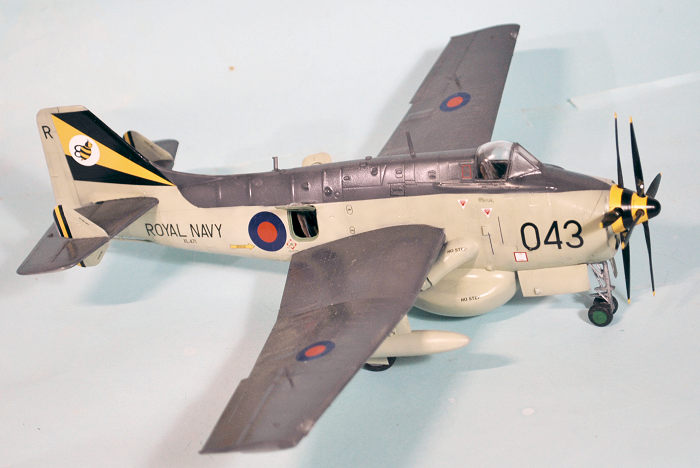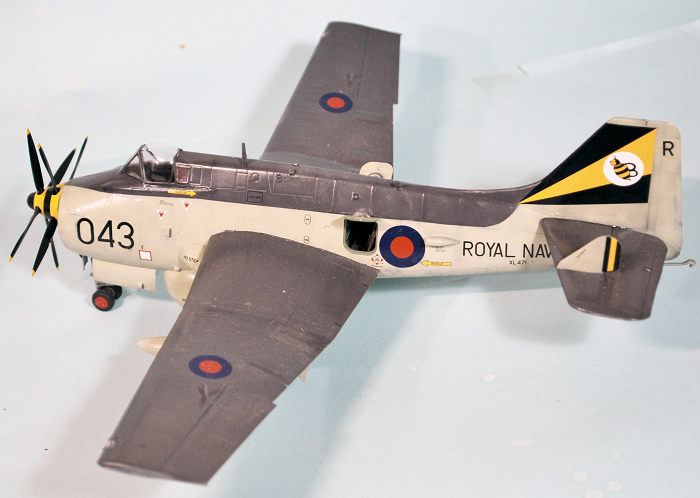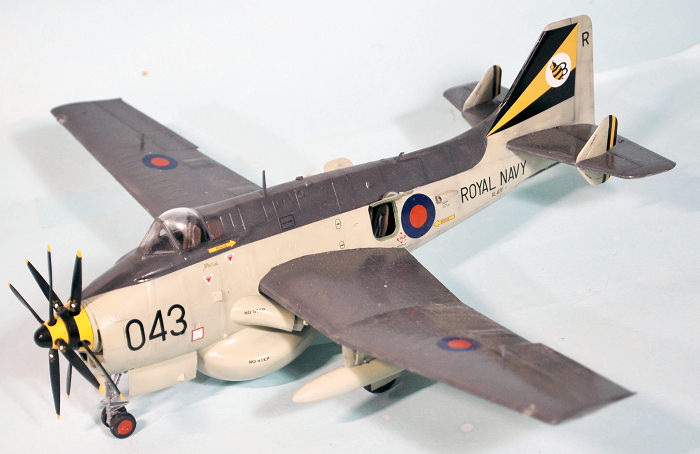
Sword 1/48 Gannet AEW.3
| KIT #: | SW48014 |
| PRICE: | ~$80-90.00 in US stores; cheaper overseas |
| DECALS: | Two options |
| REVIEWER: | Tom Cleaver |
| NOTES: | 2024 release |

| HISTORY |
The battle against the kamikazes in World War II demonstrated the need for the earliest possible early warning of attack. The solution was to raise the search radars high enough to expand the ďhorizonĒ around the task force, which was achieved after the war by creating airborne early warning. The first aircrfaft t o carry a search radar was the Douglas Skyraider. During the mid to late 1950s, the Royal Navy operated detachments of Skyraider AEW.4 aircraft from its carriers.
The Skyraider was obviously approaching obsolescence at the time it was adopted, while the need for a more modern AEW aircraft became more pressing. The Royal Navy issued AEW.154 to initiate planning for a Skyraider replacement. The most-suitable aircraft were those under development in the GR.17/45 specification for a new anti-submarine aircraft. The Fairey Type Q/17 was declared the winner and entered service as the Gannet.
A decision was made to use the Gannet as a stop-gap measure prior to the development of a new, purpose-built aircraft for use on the planned new generation of aircraft carriers. The Skyraiderís AN/APS-20 radar would be mounted under the fuselage.
 However, the radomeís size meant the Gannet airframe would have to
be modified since it was too close to the ground to accommodate the radar.
The fuselage was radically changed, with the removal of the two observerís
cockpits and the creation of a new compartment within the fuselage at the
trailing edge of the wing. This meant the turboprop exhausts had to be moved
forward from this position to the wing leading edge. The additional area of
the radome created directional instability, which required a larger vertical
fin and rudder to compensate. Finally, the landing gear needed to be to
increase clearance for the radome.
However, the radomeís size meant the Gannet airframe would have to
be modified since it was too close to the ground to accommodate the radar.
The fuselage was radically changed, with the removal of the two observerís
cockpits and the creation of a new compartment within the fuselage at the
trailing edge of the wing. This meant the turboprop exhausts had to be moved
forward from this position to the wing leading edge. The additional area of
the radome created directional instability, which required a larger vertical
fin and rudder to compensate. Finally, the landing gear needed to be to
increase clearance for the radome.
The extensive modifications led to a suggestion that the AEW version be renamed the Albatross, given it was to all intents and purposes a completely different aircraft. However, by the time the Gannet AEW began entering service in the early 1960s, the ASW Gannet was in the process of being replaced.
The Gannet AEW.3 prototype first flew in August 1958; carrier trials were held aboard HMS Centaur in November, and the first production aircraft was delivered in December. 700G Naval Air Squadron was formed in August 1959 as the Trials Unit for the new aircraft; the intensive test program lasted until January 1960, at which point the unit became 'A' Flight of 849 Naval Air Squadron and was embarked aboard HMS Ark Royal. A total 44 Gannet AEW.3s were delivered by 1966.
The Gannet AEW.3 had limited command and control capability, since it had no onboard computer(unlike the contemporary E-2B Hawkeye) and used the AN/APS-20 S-Band search radar and AN/APX-7 IFF set, connected to the AN/ART-28 Bellhop datalink, which transmitted information to the operations room on the aircraft carrier, where intercept directions were given to the CAP.
 The Gannetís three-man crew consisted of the pilot and two observers
in the fuselage compartment. The aircraft had a typical endurance of 5Ė6
hours at 25,000. The airplane cruised on one engine of the Double Mamba,
alternating between the engines every 30 minutes.
The Gannetís three-man crew consisted of the pilot and two observers
in the fuselage compartment. The aircraft had a typical endurance of 5Ė6
hours at 25,000. The airplane cruised on one engine of the Double Mamba,
alternating between the engines every 30 minutes.
849 NAS operated the AEW.3s in four operational flights plus the HQ flight. The HQ flight was stationed at three Fleet Air Arm air stations over the period of Gannet operation. Each flight operated four AEW.3s and a Gannet COD.4 for ship-to-shore communications. Five Royal Navy carriers operated the Gannet AEW flights.
The British governmentís decision in the mid-1960s to cancel the planned new carriers led to the withdrawal of fixed wing aviation in the Royal Navy. C Flight was disbanded following the withdrawal of HMS Centaur; A Flight was disbanded in 1970 when Hermes was withdrawn; D Flight disbanded in 1972 when Eagle was decommissioned. The final operational AEW.3s were operated by 'B' Flight aboard HMS Ark Royal until her final decommissioning in 1978 Ė a Gannet AEW.3 XL471 of 849B Flight was the last aircraft to land on the ship on Saturday 18 November 1978.
849 Naval Air Squadron was disbanded in December 1978 following the decommissioning of Ark Royal, wich left the RN with no emb edded airborne early warning. The RAF took over Airborne Early Warning for the UK Air Defence Region, with the radars originally supplied with the Skyraiders taken from the Gannets and fitted to the obsolete Avro Shackletons. The lack of organic AEW capability for the navy following the withdrawal of the Gannet was seen as misguided, particularly following the experience of the Falklands War, where four ships were lost due to the Task Force being reliant on shipborne air search.
| THE KIT |
Sword first released the Gannet AEW.3 as a 1/72 kit in 2018. This 1/48 kit, which was released in April 2024, is a direct scale-up of the earlier kit, with that kitís resin electronics compartment reproduced in injection plastic. Decals are the same for each kit, being an AEW.3 flown off HMS Hermes in 1963 and the AEW.3 XL471 last operated aboard HMS Ark Royal.
| CONSTRUCTION |
This is a limited-run kit. Test fit four times before gluing once. You will need to clean up parts so they fit. The instructions have you assemble the landing gear inside the wells before fitting the wells inside the wings and fuselage. I tried to delay that process, but it turns out that assembling the landing gear after placing the gear well assembly in the fuselage is nearly impossible. You do need to follow the instructions here, and yes - it will result in breakage no matter how careful you are. The nosewheel leg has been reattached three times during the course of constructing this model. You have been warned.
 I assembled the wings and attached them to their fuselage half before
further assembly of the fuselage, so that I could work the attachment of wing to
fuselage from inside and outside the fuselage; the attachment is similar to that
in the Monogram/ProModeler SB2C Helldiver, and equally easy to get wrong if you
wait to do this until the fuselage is fully assembled.
I assembled the wings and attached them to their fuselage half before
further assembly of the fuselage, so that I could work the attachment of wing to
fuselage from inside and outside the fuselage; the attachment is similar to that
in the Monogram/ProModeler SB2C Helldiver, and equally easy to get wrong if you
wait to do this until the fuselage is fully assembled.
The pilotís cockpit and electronics operators compartment both fit well inside the fuselage. I used Eduard seatbelts from their Gannet photoetch set. If you decide to build the model closed up, you need to put the fore and aft bulkheads in place to strengthen the fuselage sub-assembly.
I left the nose part off the fuselage until the rest was assembled, so I could put sufficient weight inside to insure nose-sitting. There is plenty of room in there between the floor of the cockpit and the roof of the nosewheel well, so there was no problem with getting enough weight inside. When that was set up, I attached the nose cap.
| COLORS & MARKINGS |
 I used Mr Color C-333 Extra Dark Sea Gray and C-369 Sky, thinned 50-50
with Mr Color Leveling Thinner.
I used Mr Color C-333 Extra Dark Sea Gray and C-369 Sky, thinned 50-50
with Mr Color Leveling Thinner.
When I do this FAA scheme, I apply the EDSG color first, then mask it off - since it takes less masking - and then apply the Sky color. I post-shaded both colors a bit. Research at the Thunder & Lightnings site revealed that the landing gear, wheel wells and inside of the gear doors are painted Aluminum lacquer. I used Tamiya Silver XF-11 for this. Fortunately, masks are provided for painting the spinner.
After I unmasked the model, I gave it a coat of Micro-Scale gloss clear. The decals went on without difficulty and snuggled down under an application of Micro-Sol.
I gave the model an overall coat of Micro-Scale Satin clear, which looks more accurate as an in-scale glossy finish. I assembled the props and spinner and attached them, then unmasked the pilotís canopy and the hatches for the electronics compartment, which I posed open.
| CONCLUSIONS |
This is not a difficult model, if you bear in mind that it is limited-run. Study the assembly instructions. The result is Big, Ugly and British - for some of us, those are a feature, not a bug. Recommended for modelers with experience assembling limited-run kits.
Review kit courtesy of Sword.
12 September 2024
Copyright ModelingMadness.com. All rights reserved. No reproduction in part or in whole without express permission of the editor.
If you would like your product reviewed fairly and fairly quickly, please contact the editor or see other details in the Note to Contributors.
Back to the Main Page Back to the Review Index Page Back to the Previews Index Page